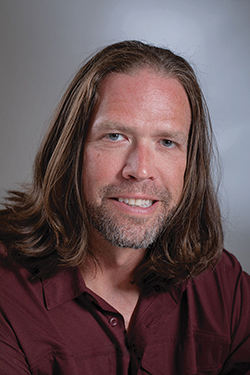Multiple Myeloma Survivor
Going The Extra Mile

Kenny Capps had always been physically active, so a multiple myeloma diagnosis at 42 years old was shocking. Because few resources were available for a young man with multiple myeloma, he created the non-profit organization Throwing Bones to provide support and inspiration for others like him.
I began racing at the age of 13, when Dad bought me my first road bike. For the next 30 years, I swam, ran and biked my way to a lot of podium misses. I told myself I didn’t compete to win; it was only about the process. As I got older, the distances got longer and the terrain steered mostly to the trails.
I started running distances longer than a marathon in 2011. I could lose myself in my surroundings. I could separate, analyze, compartmentalize and outright reject pain in the rest of my life.
In October 2014, after feeling tired and having flu-like aches, I went to my family doctor. The blood test showed I was anemic — strange for somebody with my self-awareness. I thought I was doing all the right things to make sure I was healthy.
After more tests and a couple more months, the doctor said it was time to bring in the big guns. I went to see our local oncologist who told us I had multiple myeloma, a blood cancer that I never knew existed. I was young for the disease. The next step was to find out how sick I was. I was told not to Google the disease. So, the first thing I did was go home and Google it. At that time, many Internet sites about multiple myeloma said I had 3 to 5 years to live. I lost a lot of sleep those first few days.
I looked for support and discovered that finding the right support group is important. If the first one isn’t helpful, find another.
I made trips to two major cancer institutes before I finally saw the reason for my back and bone pain on imaging test results. They found fractures and lesions in my spine, collarbone, clavicles, scapulas, ribs, sternum and my left hip.
I started treatment immediately. The side effects were mana-geable but frustrating. One drug drained my energy. Another caused neuropathy in the bottoms of my feet. A third drug made it nearly impossible to sleep one or two nights every week and gave me the hiccups! By the middle of summer, I had developed a hand tremor. I have no idea which drug caused that.
On the day that I received my follow-up PET results, my health care team stopped my running. The lesion in my hip scared them. If I broke my hip, my problems would get a lot worse. I cried. I often think of myself as a tough guy, but I was lost in that moment. My ability to cope was tied to my ability to run.
After several months of chemotherapy, the myeloma reduced significantly, and a bone marrow transplant was scheduled. Prior to the procedure, my stem cells were harvested, frozen and then reintroduced to my system. When I was first diagnosed, myeloma took up more than 80 percent of my blood plasma. Four months after the procedure, it took up less than 1 percent. The procedure gave me years that I otherwise would never have had. One bit of advice concerning this procedure – rely heavily on everyone you can. You’ll need it. This isn’t a treatment or disease that should be taken on alone.
I never hit remission, but six months after the transplant, the disease was listed as stable. I was prescribed chemo that I still take every day.
In 2016, the year after my transplant, I ran 16 races, including three half-marathons and an 18-mile trail race with 5,500 feet of elevation gain. I wasn’t the same athlete, but it meant more.
Cancer patients need help, encouragement and inspiration to get healthy, so I founded Throwing Bones to do just that. Our mission is to encourage all blood cancer patients to stay healthy and active through treatment and beyond. We hope to encourage, inspire and educate.
I have rarely been one to make small gestures, so I married my love of endurance sports with my drive to raise awareness into a giant event. In 2018, I ran 1,175 miles in 54 days on the Mountains-to-Sea Trail, averaging 23 miles each day. I ran from Jockey’s Ridge on the Outer Banks to Clingmans Dome on the border of North Carolina and Tennessee. We raised funds and awareness for cancer research and survivors, and also showed others it’s possible to live life to the fullest, even with disease. That’s when my mantra, “keep moving forward,” took hold.
Be an advocate for yourself. Ask questions. Seek positivity. Whatever you do, don’t Google it. There is hope for this cancer. Research is making enormous strides. As long as there is hope, there will be a cure. The first step is the hardest, but one step often starts another and another. Before you know it, you’ll be moving down the trail and on to greatness.


